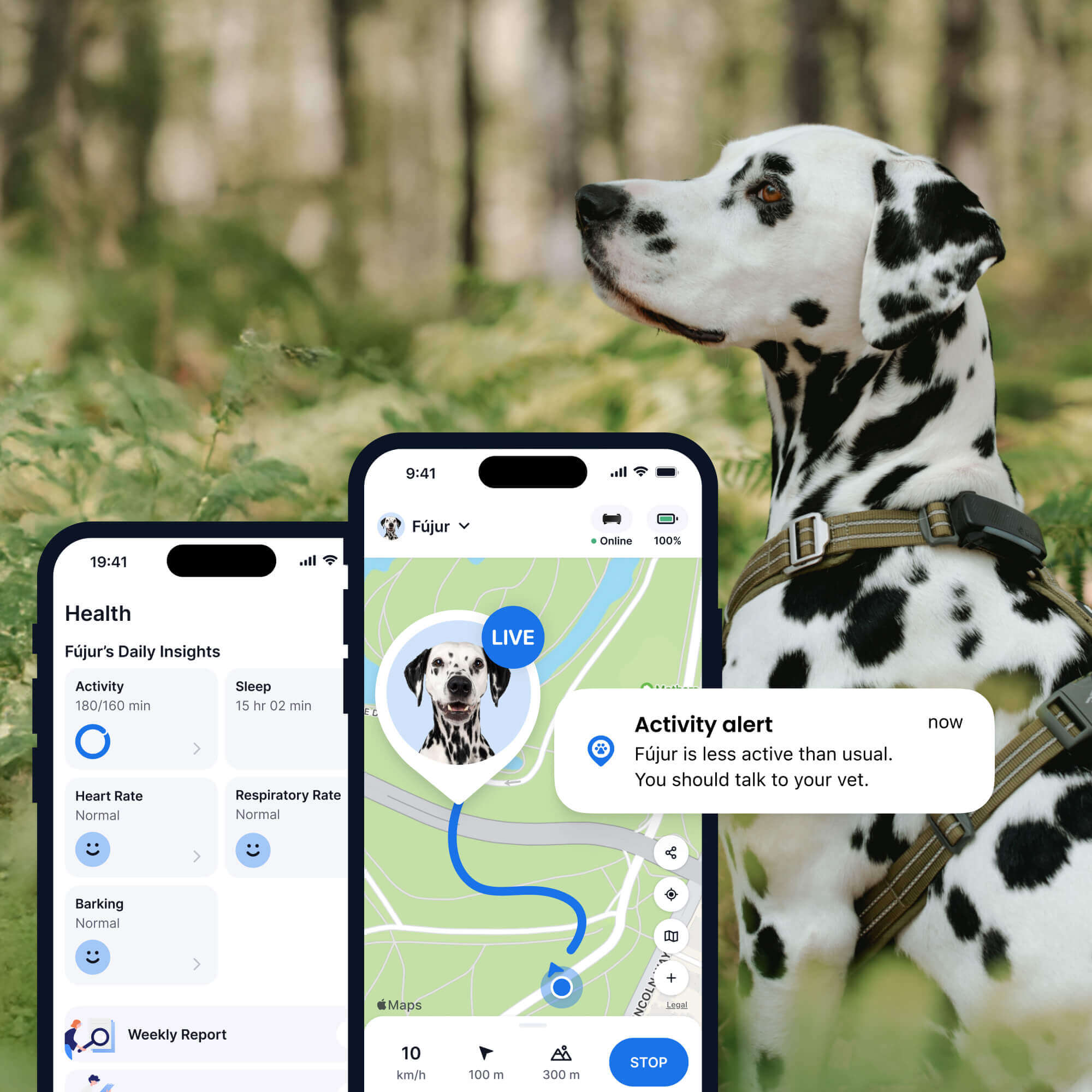 Approved by Dr. Dwight Alleyne, DVM
Approved by Dr. Dwight Alleyne, DVM Mange In Dogs: Why It Happens & How To Prevent It
Find out how to spot & treat mange in dogs this season - and how you can prevent it.

At some point, you might find your dog sniffling, scratching, or even losing fur from pesky critters like ticks, mites, dust, pollen – or mange. But what is mange in dogs, anyway? Why does it happen – and how can you deal with it? Here’s what it is and how to treat it. (Plus how tracking where your dog’s off exploring can help prevent it in the first place!)
Key Takeaways
Dogs often catch contagious Sarcoptic Mange from other infected animals at places like dog parks, groomers, or kennels, so you should be extra careful about where your dog spends time.
If your dog has mange, a vet can treat it with special anti-mite medications, dips, or oral treatments. You might still need to isolate your dog and clean all their bedding to prevent re-infection or spread to other pets.
If your dog wears a Tractive smart dog tracker, you can check their Location History to see exactly where they’ve been hanging out. This can help you figure out if they’ve been running into other infected animals so you can avoid those spots in the future.

Always know your buddy is healthy & safe
Read moreWhat is mange?
Mange is a highly contagious skin disease. It’s caused by several microscopic species of mites found in other animals. Importantly, mange is a treatable medical condition, but both you and your other pets are likely to get infected by it as well. (Though in humans, it’s more likely to be a short-term infection.)
These mites will burrow through the skin causing intense itching and irritation. The more a dog scratches, the more hair falls out in spots. Some mange mites are normal residents of your dog’s skin and hair, while others are not. However, all mites can cause mild to severe skin infections as the amount of mites and parasites increases.
Mange is a serious skin disease caused by tiny, microscopic mites that burrow into the skin of mammals.
– Cornell Wildlife Health Lab
What causes mange in dogs?
The most common cause of sarcoptic mange in dogs is the exposure to an infected animal, as the mites quickly move from animal to animal. So your buddy might be at higher risk if they’re often visiting kennels, dog parks, groomers, and even some vet clinics. All these environments may have a high exposure rate of mange, since pets often get close to each other in these areas. Sadly, if one dog in a kennel or at the groomers’ is infected, others may get infected too.
💡A smart dog tracker can log where your dog has been spending most of their time throughout the day, so you can figure out if they’ve been running into any other animals. (Whether from dog parks, woodlands, or anywhere else around your neighborhood.)

Follow your dog anywhere
Get real-time location information, wherever they go. And find out when they try to make an escape, or just when they go somewhere they shouldn’t, with Virtual Fences.
What are the types of mange in dogs?
The two types of mange affecting dogs are sarcoptic (canine scabies) and demodectic. While sarcoptic mange is the most common of the two, demodectic mange tends to also be common among young dogs in the US.
Sarcoptic mange in dogs
Sarcoptic mange or canine scabies is a condition in which parasitic mites known as Sarcoptes scabiei burrow into surface of the skin. There, the scabies mites lay eggs which hatch into larvae in about three to 10 days. These then develop into adult mites and reproduce – the lifespan of an adult scabies mite is three to four weeks.
Yes. Canine scabies is also a zoonotic disease, meaning it can be passed from dog to human.
Yes, sarcoptic mange is highly contagious and can easily pass from one animal to another.
Your dog might pick it up from direct skin to skin contact with an infected animal. Or from shared items, like bedding. In rarer cases, they might also pick it up from coming in contact with a wild animal (like foxes.)
Intense itching, chewing of the skin, hair loss around the legs and belly, patches of thick, dark skin, redness or rash, scabs or crusty skin, or even bacterial/yeast infections. In extreme cases, a severe mange infestation can show up as swollen lymph nodes from the inflammation. Your dog might also lose weight and grow weak, thin, and lethargic.
Your vet will take a scraping of the skin and examine it under a microscope to check for mites or their eggs. Even if no mites are found in the sample, your dog’s symptoms can still be a good indicator that scabies is present.
How your vet might treat sarcoptic mange in dogs
Your vet might begin by prescribing you an anti-mite treatment (i.e., a dip, topical, or oral medication – sometimes in combination.) Your vet will follow up any treatment plan with a few more rounds of skin scrapes to see if your dog is infection-free or needs more treatment.
Be sure to follow the vet’s instructions carefully and give your dog the full course of treatment; otherwise scabies may persist. Your vet will follow up any treatment plan with a few more rounds of skin scrapes to see if your dog is infection-free or in the need of more treatment.
You may also need to treat other pets in your household, as well as wash or remove any bedding or toys that may be infested. Your vet may also recommend that you isolate your dog to prevent the spread of mange from pet to pet or human to human.
Demodectic mange in dogs
Another common type of mange in dogs is demodectic mange. It’s caused by the cylindrical, cigar-shaped mite with eight legs known as Demodex canis. Unlike scabies, these mites are always present (even on healthy dogs). They reside in hair follicles rather than burrow into the skin. Normally, they cause no harm. It’s only when a dog’s immune system is compromised that demodectic mites are able to grow out of control (i.e. reproduce rapidly) which causes the problem.
Dogs with a weak or immature system, including those less than 18 months old, senior dogs, malnourished/sick dogs, or dogs on certain medications.
No, neither to other pets nor humans. It can only be passed from mother dogs to their puppies in the first few days of life. Since the mite is found on all dogs, they’re not a threat to dogs with a healthy immune system.
In general, watch out for signs of lethargy or weakness. (Like if your dog seems less active or less enthusiastic around walks.) These signal your dog’s immune system is compromised. Localized demodectic mange can turn up as patches of hair loss and scaly skin on your dog’s ace. Generalized demodectic mange can infect parts of your dog’s body besides their face, so they might become smelly or itchy. Demodectic pododermatitis can affect your dog’s paws.
Much like sarcoptic mange in dogs, your vet might take a skin scraping from your dog and examine it under a microscope to diagnose demodectic mange. If a large number of mites are found, the diagnosis is confirmed. Your vet might also use a skin biopsy to diagnose the condition.
How is demodectic mange diagnosed & treated?
Depending on your dog’s condition, your vet will advise you on the best course of treatment. They might prescribe you medication, topical ointments, and/or medicated baths. Some types of oral flea and tick products have also proved effective to treat mange in dogs.1
⚠️ Make sure to follow your vet’s instructions to the T and only use products built for dogs’ skin. Shampoos that are designed for humans might be harmful to dogs and contain ingredients toxic to them.
How to prevent mange in dogs
- Avoid contact with infected animals or humans.
If you suspect a friend or neighbor’s dog has mange, keep your dog away. You won’t be able to tell which type of mange the dog has so your pup could get infected. (Which means rescheduling a few of those dog park or puppy play dates until everyone’s been to the vet.) - Be extra mindful of your dog’s hygiene.
It might sound obvious – but don’t skip out on bathtime! (Yes, no matter how much your dog protests.) Give your dog regular baths and wash bedding and collars. This may help prevent your dog from getting mange. - Stay on top of your dog’s diet & exercise.
Some cases of mange in dogs might occur because their immune system isn’t functioning too well. Make sure to keep your dog on a regular feeding schedule, with lots of water and healthy meals, plus plenty of exercise. Include a high dosage of vitamin C and A, zinc, vitamin E in your dog’s diet. Your vet could also prescribe you medically-approved dog food options to help keep your buddy healthy. - Try and minimize stress in your dog’s environment.
Constant stress can compromise their immune system with time. This makes them more at risk for certain types of mange. - Don’t skip out on your preventive medication.
Keep your dog on a vet-recommended, broad-spectrum parasite preventive year-round. Many of these products are effective against the mites that cause mange, as well as fleas and ticks. - Be cautious when out in public.
Especially dog parks, kennels, and grooming facilities. Make sure these environments are clean, and consider bringing your own grooming tools if you use an outside groomer.
Where a smart dog tracker can help
Mange can be a tricky problem to prevent and treat, since it often involves either catching mites from another animal or dealing with a stressed immune system. A Tractive smart dog tracker is a powerful tool for giving you clues about where the mites came from and for monitoring your dog’s recovery.
Strapped to your dog’s collar, you can now:
Figure out where your dog is running into mites
Sarcoptic mange (scabies) is highly contagious. If your dog has it, they likely caught it from another infected animal. You can use the Tractive app to see exactly where your dog has been hanging out. If the Heatmap shows they spend a lot of time near a specific part of the fence, a certain spot at the dog park, or near an area where wildlife is common (like foxes), that could be the “contact zone” where they picked up the mites. Knowing this spot helps you avoid it until the risk is gone, preventing a re-infestation.

Spot potential health issues early
Demodectic mange is often linked to stress and a weak immune system. No matter the type, constant itching and skin irritation will affect your dog’s well-being. Besides location, your Tractive device also monitors their activity and sleep quality. You can see if they are restless at night (due to the itch) or if they become less active and lethargic during the day because they are feeling unwell.
With time, your tracker establishes a baseline for your dog’s health. If the mite infestation or a related stress causes a major change in their activity or sleep, you’ll get an instant Health Alert. Besides, monitoring vital signs like your dog’s resting heart and respiratory rates provides objective data to share with your vet, helping them treat the skin condition and support your dog’s overall immune health.
Your furry friend’s health and wellbeing means as much as to us as it does to you. So we’ve made it a priority to only share medically-relevant content on our blog. This post was checked, double-checked, and medically verified by Georgia-based vet, Dr. Dwight Alleyne.

Dr. Dwight Alleyne, DVM
Originally from Long Island, New York, Dr. Alleyne began his career at a no-kill animal shelter before becoming a licensed veterinary technician. He graduated from Cornell University Veterinary College in 2006 and completed an internship at Purdue University. Now practicing in Georgia, Dr. Alleyne specializes in soft tissue surgery and ultrasounds. He also writes pet health articles on his website, “The Animal Doctor Blog” (www.anmldrblog.com).




